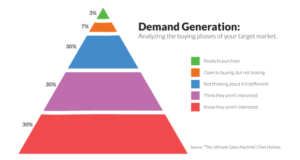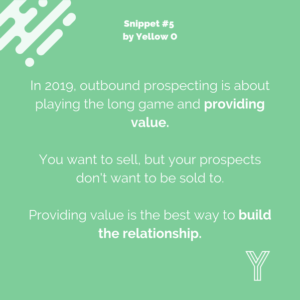Win back lost deals with this closed lost opportunity automation strategy
In most businesses, the majority of the time, money and energy is spent on acquiring new prospects and focussing on closed won business.
I get it, we all have revenue targets to hit.
However, did you know that you have a 5-20% chance of turning a prospect into a customer? or that only 30% of opportunities will become Closed-Won?
But the more important question is:
What are you doing about the other 70%? The Closed Lost Opportunities?
Now, of course, there will always be ‘tire kickers’ and prospects who are ‘not the right fit’.
Although I would argue that they should never have made it in there in the first place.
There are many reasons as to why an opportunity changes to closed lost. Here are some common reasons:
- Timing – the prospective customer might be a great fit for your product…in the near future. For whatever reason – a management overhaul, a spate of layoffs – the timing just isn’t right at this moment in time.
- Need – this prospective customer simply has no need for your product and are doing fine without you. Move along.
- Price – in theory, all your products and services would be a great fit for this prospective customer. However, they simply cannot find the room in their budget to accommodate such a purchase at this point in time.
- Competition – they opted to go with your competition instead. This is naturally a tough closed lost reason pill to swallow. Ask these prospective customers what led them to go with your competitor to see what separates you.
- Poor qualification – maybe this prospective customer should never even have been interacted with in the first place, due to the fact that they don’t come close to fitting the traits of your ideal customer profile.
If you’re a SaaS business it could be lack of features or integrations.
In truth, it will be different for everyone.
However, I’m a firm believer that “no” in business doesn’t mean no forever, it usually means no for now…
For example, take a look at the buying phases of your target market.

The majority of prospects are either
- Neutral, meaning they haven’t even thought about your products (but may be interested)
- Satisfied with their existing solution (but not completely unreachable)
- Completely uninterested in your product or service (good luck)
So what are you going to do with the 70% of closed lost opportunities?
I recently shared this advice about outbound prospecting. And it applies here.

And Marketing Donut found that 63% of the people requesting information from your company today will not purchase for at least three months – and 20% will take more than 12 months to buy.
So you need to swallow your pride and provide them with value…
- You become the go-to brand for your specific niche.
- You share your insights and lessons learnt on your blog
- You produce content which helps them achieve their career goals
- You invite them to your in-person events
- You include them in your webinar series
You keep nurturing the seed of your brand and solution in their mind until they are ready to buy.
And you use Marketing Automation to do so.
This particular automation involves integrating your CRM and Marketing Automation platform (sometimes these can be the same tool).
In this example, we are using the following tools.
- Hubspot – CRM
- Autopilot – Marketing Automation
The Setup:
Please note that you will need to spend time creating the content for the various sequences below.
- Create Closed Lost Reason field Make this a drop down and mandatory Add an additional field for dates (where relevant) or competitor name
- Create multiple nurture sequences based on the closed lost reason value Sequences will be different based on reason Some sequences will be internal only (poor qualification)
- Eject “Open leads” when prospects engage
- Review and optimise
The video (above) walks you through the setup and offers ideas as to the type of content you need to produce throughout the different journey’s.
Automation instructions
So, on the next couple of pages, I’m going to show you what it looks like in the CRM. And what that looks in the marketing automation platform.
So first of all, here is just an example pipeline.
I’ve got the Growthmentor deal it’s £23,000, it’s a big one, looking forward to them opening up their chequebook.
But, unfortunately, they went with the competition.
So I need to change this now to closed lost in my pipeline.
And as I do that, I get asked to select a closed lost reason.
As you can see, I can’t save this deal until I select a closed lost reason.
So I’m going to go through here and I’m going to select the lost reason. In this case it was price, I was just too expensive for the team at Growthmentor for what they were hoping to achieve.
So, I’m going to click on save.
Now that I’ve done that, that’s saved in my CRM and because my CRM and automation platforms are integrated, it will trigger a sequence in Autopilot because Autopilot’s constantly looking out for any changes to the closed lost reasons.
Now, the next slide I show you is going to look quite complicated but it really isn’t, and I’ll take some time going through each of the sequences.
Here, you can see that there is a trigger, a condition, and then an action.
And ultimately, every automation pretty much has these three steps.
- A trigger – something happens
- A condition – so is this person or is on this list, or has this field completed?
- An action – like send an email, send a piece of direct mail if you’re using that as your channels to communicate with prospects and customers.
Going back to this automation and this example pipeline, when the deal stage is closed lost, we need to trigger this automation.
And what these different conditions are checking for is the closed lost reasons.
And I’ll go through each of them in just a second.
Now with these closed lost reasons, depending on what the reason actually is there will be a number of emails that can be sent to the prospects, as well as notifications internally to the sales team.
It could be that they just go on to be added to a list and within that list a different automation is triggered.
Like I said, this is just an example, there isn’t content within these emails. For the delays, I’ve just put in numbers and pulled them out of the air.
However, it’d take a bit of time for you to understand exactly what the best sequence should be for you.
Closed Lost Reason – Competition
For example, the first field that we’re checking for is, if we have lost out to the competition.
If we’ve lost out to the competition, we want to still communicate with the prospect.
And from my experience in recruitment, I used to speak to the companies that I lost out to when another agency placed in that role.
Around 10% of the time, that candidate that started, ended up being no good. So I would check up with the client that was hiring 30 days after the new hire had started.
Because within about 30 days they’ll have a feeling of whether that person is going to be right for them and their business, and it’s exactly the same with the software.
There may be a chance that the prospects that go with your competition, might not actually be happy with the solution they selected. We’ve all been there, we’ve bought a tool, a product, or a service and it hasn’t quite lived up to our expectations, or hasn’t lived up to what the marketing site said it would.
So this is why you want to continue to nurturing and providing content and value to those that have gone with the competition.
Now you may not want to say, “we’re better than x because of this”, instead you need to provide value and help them achieve the goals that your product actually provides the solution for.
This is action is a notification, which is internal. So this goes to the sales rep who was managing this opportunity. And in that notification, you may add a task for that sales rep to call them or to send a personal email, or to send a message on social.
Again, the different sequences depend on your unique business, your team, your resources and your understanding of the market.
Closed Lost Reason – Features
Moving on to the second sequence, the closed lost reason for this is features.
Perhaps they didn’t have one of the features or integrations that you needed. So, in this case, I’ve added this prospect who matches this criteria, to the roadmap list.
Now they can be updated when new features are released and deployed.
Now, if you had that additional field that I mentioned before, and you wrote down the specific feature, you may then want to segment this list even further.
Based on what specific features they were looking for so that when your product team releases that feature you can send a message to them or invite them to a beta program.
There have been dozens of companies that have been doing this recently (see below). And it’s working extremely well.
 Closed Lost Reason – Timing
Closed Lost Reason – Timing
The closed lost reason is timing. So, again, you’d want to send them content based on if now’s not the right time, understanding when is the right time or what triggers can happen in their career, in their market, in their general day to day that would cause them to speed up the time that they would need your product, service, or solution.
Here you can also add internal notifications to remind a sales rep to follow up.
I’ve only put in a few emails, this email sequence could last a year, again, it’s completely dependent on your industry and your business.
Closed Lost Reason – Price
This one is the price. So you maybe wanted to communicate why, I mean, you don’t wanna say why your price is expensive, but you can justify it with the social proof of the results that your existing customers are achieving, even though the price is a little bit more expensive than the customer, so it’s really focusing on the differentiation and positioning of your brand versus the competition here.
Closed Lost Reason – Need
This one is the need, so, they just didn’t have the need or they didn’t truly understand that they do have the need.
Here you should, produce content, providing value, helping them achieve what it is they do. And again, this is all about planting the seed for them coming back to you when the time is right.
Closed Lost Reason – Not Qualified
This final one here, I haven’t actually configured it yet so let me show you how to do that. So the field is lost reason, it equals, and it’s poor qualification.
This is super important, we really want to know the leads and prospects that come into our opportunities that aren’t the right or have been poorly qualified.
Because that is an area for marketing to improve their qualification process, or the sales team to improve their qualification process.
It’s really important that you know that information so that you can save time and make sure that you’re focusing on the right sales leads and opportunities in the future.
And if it is a case of poor qualification, you need to understand why that traffic is coming to your website in the first place. Is your messaging off? Is the content not quite right for explaining the value that your product solves?
This would be added to the list and a notification would go to your Marketing or your Ops person or your SDR so they can review the journey of that prospect.
I would recommend reviewing these on a bi-monthly basis, either twice a month or once a month and just try and understand why these people have been poorly qualified to help you close the gap there.
What happens when a prospect re-engages?
The final part of this is just to have a catch-all element in here.
So this trigger is looking for any lead status or contact status that is open.
Let’s take an example…
The closed lost reason here was that they didn’t quite have the need. However, let’s say after an email that was sent six months down the line, they actually do have a need or that pain point really arises again and they come back to your company for help.
If that is the case, their status within your CRM would change to open because they are a contact or a prospect that you’re actively working on.
Therefore you’d want to eject them from this journey so they don’t continue to, receive content related to that objection, that closed lost reason, which no longer applies.
So I hope that all makes sense, and I know it looks very daunting but once you set it up, it’s pretty much a case that you can duplicate these sequences and drop in the right content in the right place.
Want to increase your revenue?
People come to me when they’re struggling to get replies, book meetings, and close deals through outbound sales.

